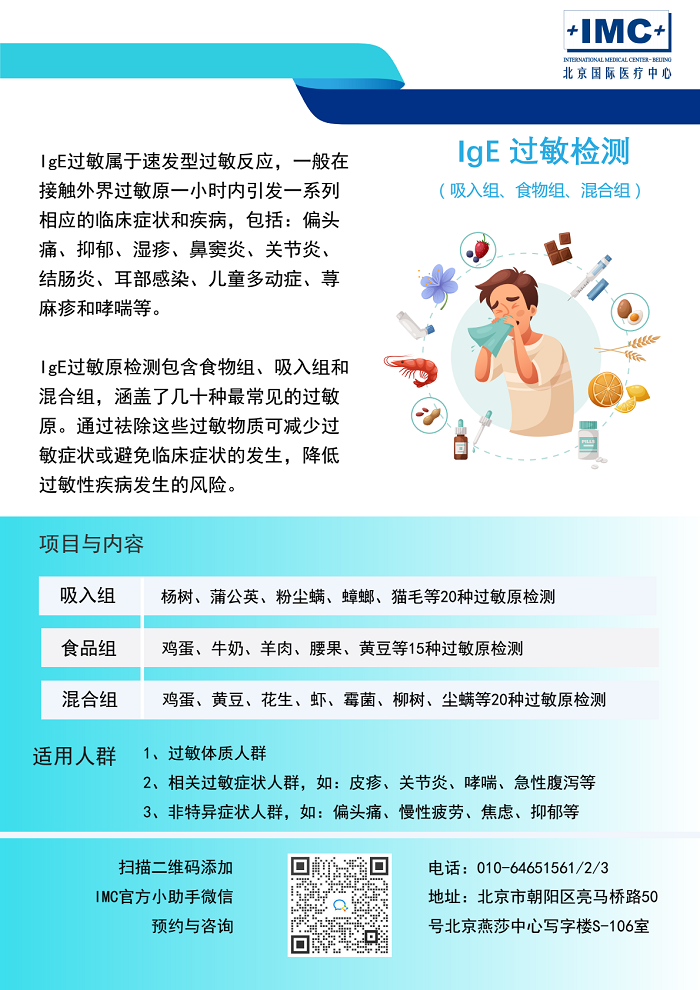News& Information
-
Medical Trends
 Home -> News& Information -> Medical Trends
Home -> News& Information -> Medical Trends
The difference between food allergy and food intolerance
Author:Dr.Sunny Kim
Food intolerance is a strange name for most people's first reaction, and some people think it is allergy. In fact, there is a difference between the two. Today, I would like to talk about the difference between food allergy and food intolerance.
1. About food allergy
(1) What is a food allergy?
Food allergy is caused by exposure to one or more specific foods, or foods containing a specific food protein, causing an abnormal reaction of the body's immune system, resulting in allergic symptoms.
(2) What is the cause of food allergy?
Food allergy includes several reactions mediated by IgE, non-igE, or a combination of the two. Among them, IgE mediated food allergy is relatively common and its mechanism is also clear. The immune system will produce a specific antibody called immunoglobulin E(IgE) against the allergen when the human body first contacts the food that causes allergic reaction. When the human body contacts the food again, the allergen will bind specific IgE and cause the body to release histamine and other inflammatory mediators, thus causing allergic symptoms.
(3) What are the inducible factors of food allergy?
Genetic factors - people who have allergies in their family (such as asthma, food allergies, atopic dermatitis, etc.) and who have allergies themselves have an increased risk of developing food allergies.
Environmental factors - Solid foods added to supplementary food too early or too late, cesarean section in children, and prolonged exposure to tobacco smoke may increase the risk of developing food allergies.
(4) What are the typical symptoms of a food allergy?
Acute urticaria and angioedema are the most common skin manifestations of food allergy, as well as the appearance of skin erythema, severe itching. In addition, there will be facial, lip, throat edema, dyspnea, nausea, vomiting, abdominal pain, diarrhea, can cause anaphylactic shock when serious.
(5) What is the examination method of food allergy?
In addition to the doctor's physical examination of the patient, there are also food stimulation tests, skin tests, patch tests, serum specific IgE test, CBC.
(6) How should be treated when symptoms appear?
If acute urticaria with itching or even vomiting and diarrhea, difficult breathing appear immediately after eating, seek medical treatment as soon as possible. Drug therapy includes antihistamines, hormones, and so on.
(7) How to prevent food allergy effectively?
If the allergen is clear, food containing allergens should be avoided. If the allergen is not clear or there is an allergic reaction to a variety of foods, food that is likely to cause allergies should be consumed as little as possible

About food intolerance
(1) What is food intolerance?
Food in the digestive tract, should be digested into amino acids and glucose levels to be absorbed completely, but a lot of food, because of the lack of the corresponding enzymes and cannot be digested, but in the form of peptides or other molecules into the intestine, where they were mistaken for foreign substances, which can lead to immune reaction, and produce food specific IgG antibody. IgG antibodies form immune complexes with food particles that cause inflammation in all tissues and manifest as symptoms and disease in all systems of the body.
(2) What are the symptoms of food intolerance?
Chronic diarrhea, abdominal pain, indigestion, obesity, fatigue, skin rash with itching and other symptoms may occur if the food is not tolerated for a long time.
(3) What methods can be used to detect food intolerance?
Specific IgG antibodies are tested to determine whether the body has an intolerant response to a particular food. At present, up to 90 kinds of substances in food can be tested. The classic food intolerance test includes 14 items: beef, chicken, cod, corn, crab, eggs, mushrooms, milk, pork, rice, shrimp, soybeans, tomatoes and wheat.
(4) How to treat food intolerance?
Under the guidance of the doctor, the diet should be adjusted reasonably to determine which food should be avoided, which food can be replaced in turn, and which food is safe. Through a period of adjustment, the symptoms can be effectively alleviated.





